The numbers aren’t going to make you feel any better, or dissuade your from the idea Notre Dame outplayed Ohio State on a down-to-down basis and let them off the hook. The Irish firmly won the efficiency battle, and despite the 61-yard TreVeyon Henderson touchdown were dead-even in stats the account for explosiveness like yards per play and EPA. Predicted post-game win probabilities ranged from 61% to upwards of 95%. This is a sickening loss, and a missed opportunity, on every level.

The positive spin here is tough to sell – any praise Marcus Freeman and the staff deserve for getting the program to the place where they can outplay this talented Ohio State team is outweighed by the failures to execute and put players in position to succeed in big moments.
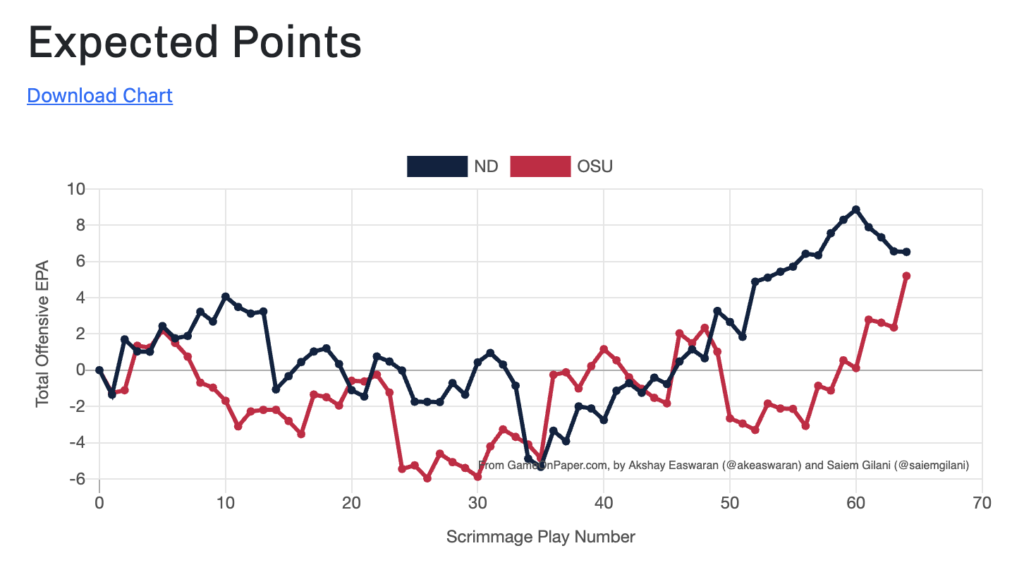
There was no garbage time in this game, for obvious reasons, but as always end of half plays have been removed (in this case kneel-downs and the final ND desperation play).
Stats from a few excellent sources – College Football Data, Game On Paper, and often referencing SP+ and FEI numbers. If you get lost, check out this handy advanced stats glossary here or reach out in the comments.
The worst-best success rate graph I’ve ever made
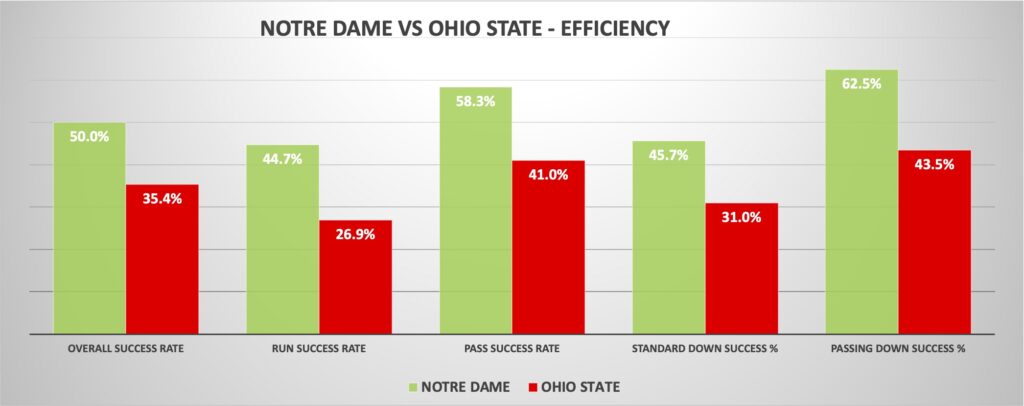
There’s no “good” way to lose a big game at the last second. Not on a controversial call, like questionably pushing your QB into the end zone before that’s a thing or offensive pass interference that’s hardly ever called and may not have even taken place. Not on a failed two-point conversion, or a late drive to win that’s snuffed out. Notre Dame fans have experienced all kinds of different flavors of this pain, and they’re all miserable.
But this way, I’m pretty confident is the worst. It’s a lethal combination of the graph above – showing that Notre Dame was winning enough plays by a solid margin that they should have walked away with the win – and the extra shiv to the gut that the Irish didn’t even have enough players on the field on the final, deciding play.
The “ten men on the field” piece puts a twisted filter on every part of how this game is discussed – it makes the final drive less about a gritty Ohio State comeback and more about ND incompetence. It draws the shaky calls and execution earlier in the game – whether 4th down attempts, play-calls on the last offensive series, or blitzes and coverage decisions in the 4th quarter. It will follow Freeman now through every late-game situation and removes the benefit of the doubt for any subsequent mistakes, minor or major, for a long time. It’s gutting for a fanbase desperate to see this coach succeed – we knew there would be mistakes for a first-time head coach, but it’s impossible to swallow one this egregious and consequential.
Back to the numbers…
At this moment in time, the success rate wins across the board above still tell us a lot about this Notre Dame team. It was a winning performance by the offensive line, creating consistent rushing success against a Buckeye DL that may be entirely comprised of early round NFL draft picks and not allowing a single sack. Especially in the second half, Gerad Parker and Freeman put this game on the OL’s shoulders and they rose to the occasion (more on this idea later). It wasn’t the world-changing Sam Hartman performance fans were itching for, but the passing game was very efficient in the short to intermediate parts of the field. Mitchell Evans was electric, and the offense did a terrific job staying on schedule, facing an average 3rd down distance to gain of 5.5 yards (and only two 3rd and longs [7+ yards] in the game).
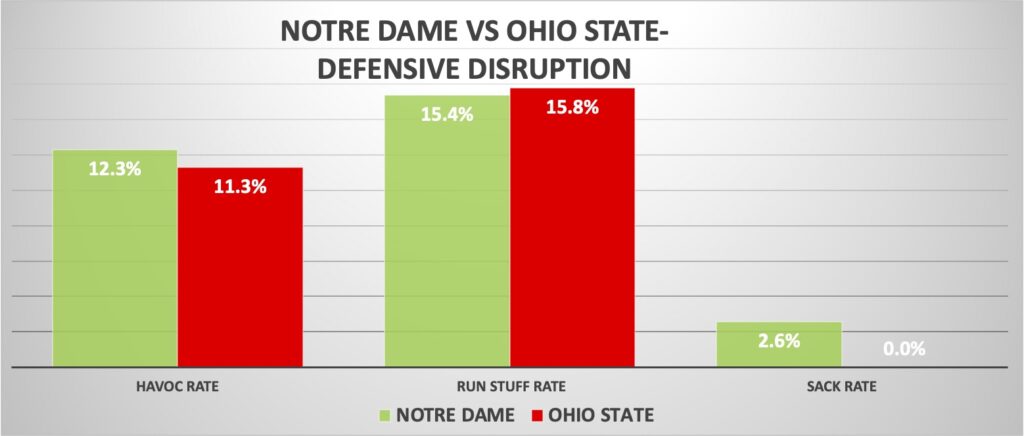
This was a strange game where both defenses pretty successfully controlled the game by bending but rarely breaking, creating a low-possession affair that was defined early by long drives that didn’t draw blood. Both Al Golden and Jim Knowles’ units did this without much havoc – both teams had just two tackles for a loss. But both defenses stiffened on short 4th down attempts, and made critical plays to keep the offenses short of the chains. The Irish defense did a lot of great things, especially Javonte Jean-Baptise, Howard Cross, and Benjamin Morrison. Kyle McCord looked unsure early but eventually settled in enough to have an average efficiency performance and find his easy-button playmakers like Emeka Egbuka, Marvin Harrison Jr., and Henderson.
Ohio State won too many of the downs that mattered most
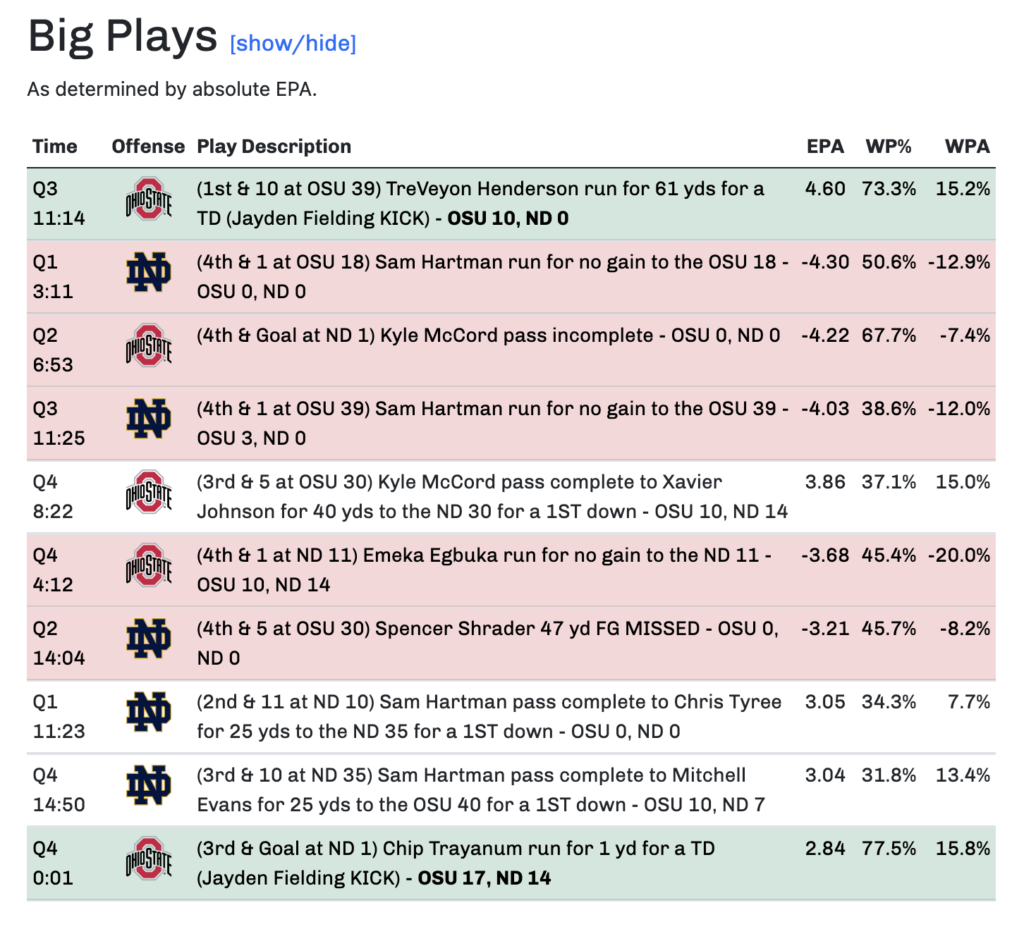
Games with success rates that uneven only have a few different paths to becoming nail-biters. The easy one is turnovers – but none to see here, despite McCord putting up several dangerous passes. The other is a wide discrepancy in converting scoring chances – but both teams saw drives stall in opponent territory and turned the ball over on downs multiple times. Unfortunately, Notre Dame lost the explosiveness battle – not by a ton, but just enough to let the Buckeyes stay right with the Irish on the scoreboard when combined with the missed early opportunities. The first two drives of the game were a killer, which felt clear even in the moment. The Irish created two scoring chances to none for Ohio State, and walked away without points to show for it (and the game a quarter shorter, which is bad when you’re the more consistent team).
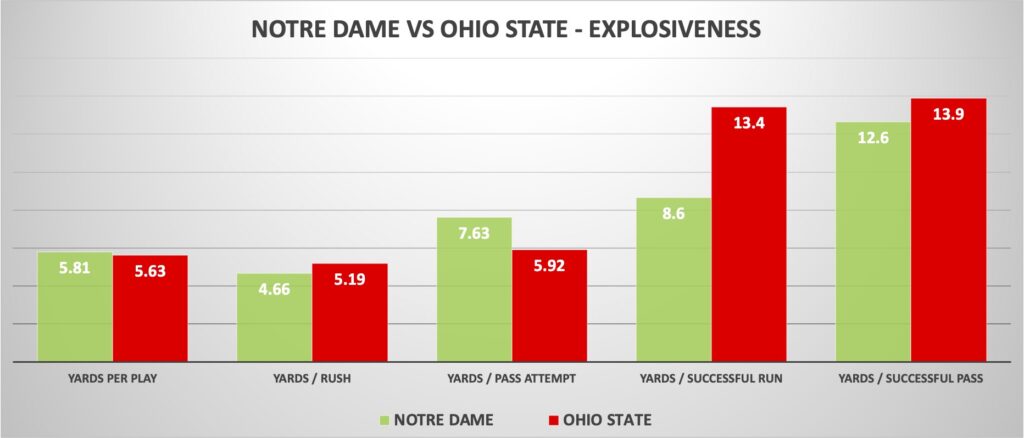
Defensively, it’s a few critical plays where Ohio State’s skill players broke contain. The Henderson run was back-breaking, but the blown coverage on Ohio State’s second-to-last drive (resulting in the 40-yard pass to Xavier Johnson) would be haunting if the Notre Dame defense hadn’t erased the impact with the incredible 3rd and 4th down stops in the red zone. The Irish were generally terrific on early downs – holding OSU to 26.7% success rate – but didn’t capitalize on enough 3rd and medium-long opportunities, where McCord was able to take advantage of the attention on Harrison to find Egbuka consistently or find mismatches (Irish linebackers on OSU RBs in pass coverage).
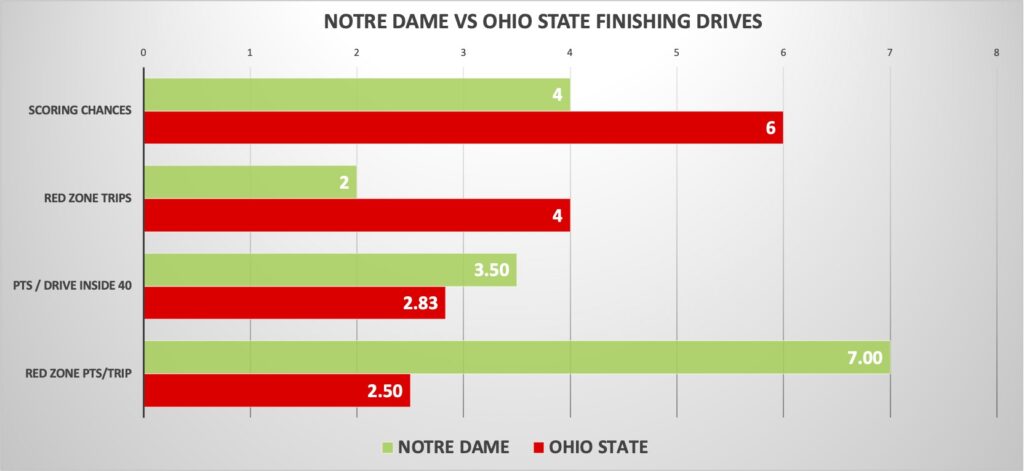
Both ND coordinators will face a lot of criticism after this loss, and Al Golden’s unit had far more successes than failures despite facing the best skill position group in FBS. The misses and failures on the last drive were loud, but so were the successful goal-line and 4th down stops. The passing defense clamped down on Harrison (even pre-injury) and made McCord string together long drives with a lot of success stopping the run (my biggest concern heading into the game).
The missed opportunities for greatness came as the Irish defense struggled to find 3rd down stops and still allowed scoring opportunities on 6 of 8 Ohio State drives. Two that stalled out were helped by Buckeye penalties that put OSU off schedule, including the absolutely massive unnecessary roughness on a converted 3rd down that would have likely put Notre Dame down two scores heading into the 4th quarter. Taking advantage of those breaks shouldn’t be taken for granted, but the stops in this game rarely came easily without more negative plays by the Irish defense.
Gerad Parker’s gameplan felt like 2022
THREAD: Notre Dame vs. Ohio State recap
This thread will be focused on the performance will do one more with specific decision-making errors
Full article herehttps://t.co/5M7IPedR1e pic.twitter.com/VFaDEp7y1P
— Notre Dame Football Stats & Analytics (@ND_FB_Analytics) September 25, 2023
On the other side of the ball, the Irish offense consistently moved the ball, but it still felt like the offensive play-calling and approach left things on the table. The failure to use significant play-action (3 of 26 passing drop backs) is unforgivable, and even more ghastly with a run-heavy game plan. It’s interesting insight into Freeman’s offensive mentality that his post-halftime interview preached staying aggressive and referenced the offensive line taking control of the game versus Sam Hartman.
The offense ran the ball on 64% of early downs, and especially in the early going that success was very hit and miss – runs on standard downs averaged only 3.7 yards per carry. It was the rare opportunities where the Irish flipped the script that things seemed to loosen up – five run plays on passing downs (especially 2nd and long) averaged 11.2 yards per carry. On a similar note, early downs pass plays went for 6.7 yards per dropback and were 6/11 on successful plays. It’s not always as simple as “run more play-action, keep defenses off balance” but that feels like it would have helped in a game where the Irish struggled to find chunk plays and had to grind out long drives.
Overall, the lack of downfield attempts and overall passing made the offensive approach feel very similar to the game against the Buckeyes in Columbus last year. It made sense then, with a huge disadvantage at QB and in a clear underdog role. But now, with a team more than ready to go toe-to-toe with Ohio State, the game plan still felt passive despite the correct 4th down attempts (which in today’s day and age should be no-brainers).
Notre Dame’s strategy seemed to stem from the idea they needed variance to win
Instead they introduced variance and put themselves in a position to let the opponent steal the game
— Notre Dame Football Stats & Analytics (@ND_FB_Analytics) September 25, 2023
Coverage Corner
While we’re complaining and I don’t have an editor, I wanted to dedicate some space for NBC’s coverage. I deluded myself into thinking that with a week away from Jason Garrett this would be a better viewing experience, fit for a game of this caliber. But no, somehow I was fooled again.
The commercial load, which I realize is an epidemic on nearly every live telecast, was awful and terribly timed. Massive review of Sam Hartman’s 4th down scramble attempt? A ruling that the viewing audience learned about coming back from the break. Notre Dame Stadium is rocking after a 4th down stop? No time to linger, no time for a replay – we’ve got Xerox ads to show dang it!
The sound levels on the broadcast are also awful, and jarring as you switch to other games on networks like CBS and ESPN. The audio experience is like watching the game in a closet with Noah Eagle and Todd Blackledge with the game going on outside. You eventually can calibrate and tell that the stadium is going crazy and is loud, but it’s so muted and distant relative to the announcing crew it’s devoid of impact. Please, someone, Pete Bevacqua, anyone, fix this in the next round of negotiations.
On to recovery
It’s a crushing defeat on so many levels – Marcus Freeman and the staff will have this hanging over them for a long, long time. A win would have simultaneously struck a blow to the Big Ten’s playoff chances and massively bolstered Notre Dame’s, building in some margin for error with a future slip-up and building a terrific case in a year that feels far more wide-open that the last several.
Beyond postseason dreams, it also would have secured a healthy floor for the season that avoided momentum stalling and an offseason of “Is Freeman the guy?” conversations. Now there’s a fairly daunting schedule remaining, and a possibility of 0-3 in the big games on the schedule. USC and Clemson become high-risk affairs, Louisville and Duke “must wins” against frisky teams on the road that will be smelling blood in the water.
Win probabilities (per SP+) remaining games:
Duke: 56.0%
Louisville: 60.3%
USC: 45.2%
Pitt: 86.2%
Clemson: 50.4%
Wake Forest: 86.0%
Stanford: 94.1%— Michael Bryan (@michaelbryanMB) September 25, 2023
Freeman, as he almost always does, has said all the right things after this loss. He takes accountability and talks about learning from the failures. We’re left to hope it’s bumps on a steady upward trajectory of what he’s building – that the hard work of building a team that can compete with Ohio State and fare this well ultimately is the tougher part and that the strategic and in-game failures can be learned over time and with experience.
The best case is that Freeman is an even greener, Midwest version of Kirby Smart. Both immediately injected some new life into recruiting, and were hired as first time head coaches with terrific mentors. Despite the perfect resume for a non-HC, Kirby initially struggled finding his way in managing several aspects of the program but learned, built strong teams, and eventually broke through. Smart had a much longer fellowship under Nick Saban than Freeman had anywhere, but it didn’t stop him from in-game blunders from clock management and a penchant for taking crazy special teams risks at the wrong time. He made a poor initial OC hire in James Coley and a poor roster management move sticking with Jake Fromm when it was time to hand the reins to Justin Fields.
Can Freeman similarly rectify his mistakes as he grows? We’ll see, and his ability to immediately galvanize the team after this loss will be a critical early sign. The Irish will travel to face a Duke team that has a budding star in Riley Leonard, who will be a pain to contain with his scrambling ability. Notre Dame should be able to win in the trenches, but with a battered receiving core this will be another stout challenge against a sound Mike Elko defense. A win keeps hopes for a successful season very much alive, a loss and things get very dark.

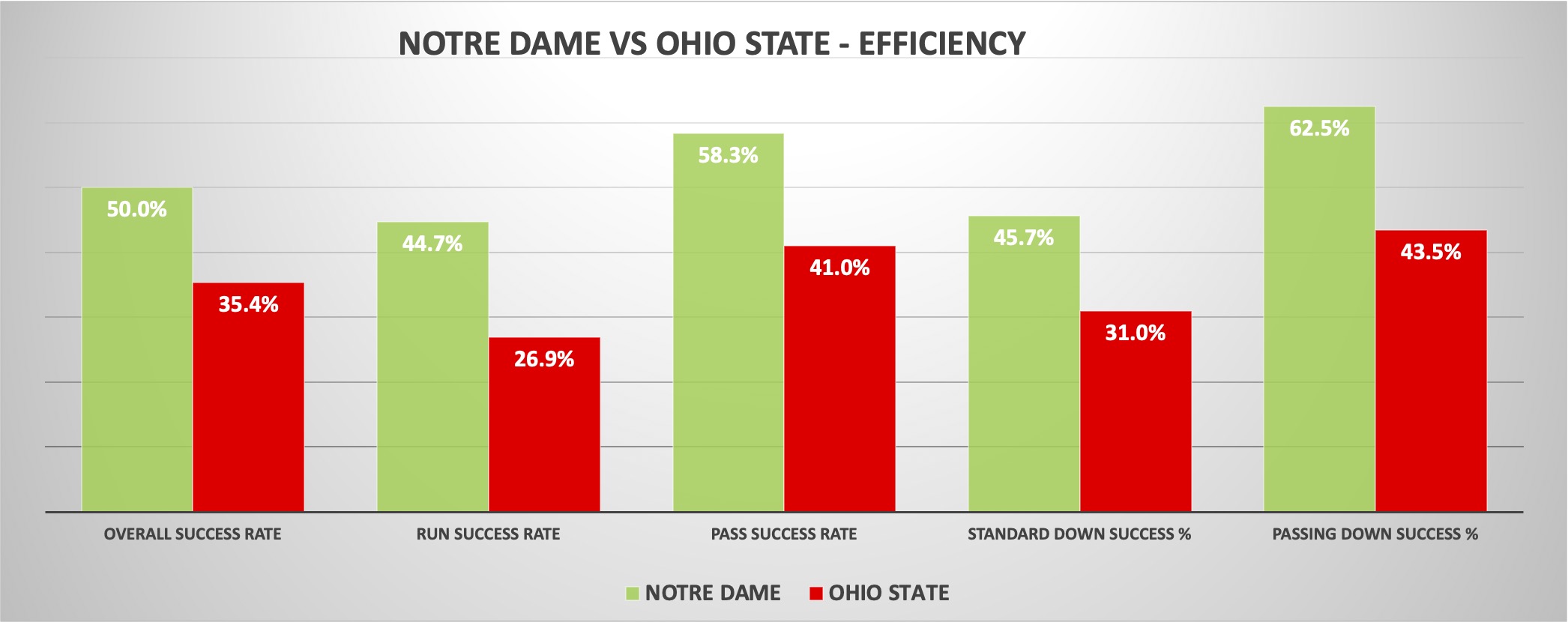



When ND beat Clemson in 2020 – as a win, it felt great, – but the advanced stats and the eye test said don’t buy it. I immediately felt that if we played Clemson again it wouldn’t go well, and of course it didn’t. I couldn’t fully enjoy that win.
Likewise, I’m actually not as devestated by this loss. One of my first thoughts after we lost Saturday was: “I hope we get to rematch in the playoff!” In the moment I would have rather been the inferior team and won, but in the long view, this is the first time in forever that I feel like after a marquee match-up we were the better team, and I wouldn’t fear to play OSU 10 more times. I actually feel more confident about Clemson/USC now than prior to the game.
Don’t get me wrong, the loss was soul crushing. But I can acknowledge that and at the same time feel better about where the program is than I can ever remember.
I saw the preview tweets from you and CFBNumbers for this article and it really makes it hurt more. To ND_FB_Analytics point the new clock rules are going to create a small, but observable increase in results like this because fewer plays will increase variance in outcomes. I spent part of the drive after the game thinking that under last year’s rules to college football ND almost certainly wins the game. Both true and ridiculous.
Here’s a stat that makes me sad: 10 out of 11 players on the field is exactly 90.9%.
Nice GIF.
Hey, can anyone with a bit of spare time to find that little moment from the first Top Gun when Jester comes into the locker room and accosts Maverick: “That was some of the best flying I’ve seen to date — right up to the part where you got killed. You never ever leave your wingman.”
On a more positive note — the latest Wake Up The Echoes (Part 4) has a truly great interview IMO with Zeke and Joe Alt. I think they might be ready to bounce back. We’ll see!
Damn, man. This must have been hard to write. I know it was hard to read. This game has been like a toothache you can’t stop poking with your tongue. Every time I feel like I can move on, I start thinking/reading/talking about it again. What I’m trying to move forward with is this: in spite of the heartbreak, we’ve still got a story to write this year. Previous gut punch losses have either not afforded that opportunity – 93 BC for obvious reasons, 05 USC because it was already our second loss – or we’ve come up short in opportunities to prove ourselves – 14 ASU, USC, 17 Miami, 19 Michigan. But if we can take care of the next 3 games – including a rare (for us) second bite at the top 10 matchup at home apple – we can still rewrite the narrative on this season, this team, and the program. This one’s going to sting for a long time though. Perhaps especially so if we manage to finish 11-1.
Total agreement.
What counts to begin bouncing back is in MF’s coach speak, practice this week. Indicators seem to be that the team came in strong yesterday.
I don’t understand how every OC isn’t aware of how much better play-action is. It doesn’t even matter if you are good at running the ball, if you run it a lot, or if you use a ton of PA. It is just more effective no matter what. And yet, it is clear soooooo many OCs, college and NFL, simply are unaware of that. 3/26 play action passes in this game is a pathetic, especially given how we had a lot of success, ergo more standard downs.
Every coach should be forced to read this article.
https://weeklyspiral.com/2021/10/29/play-action-passing-is-the-best-play-in-football/